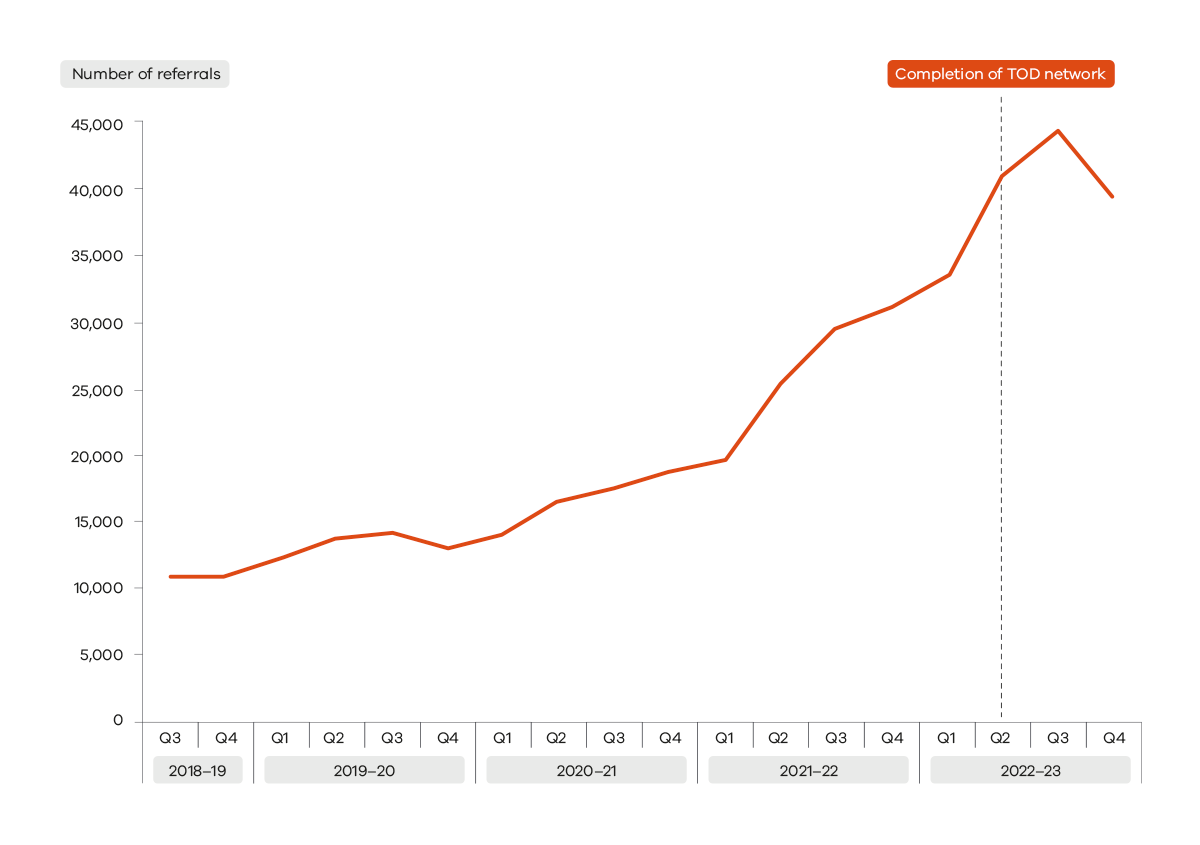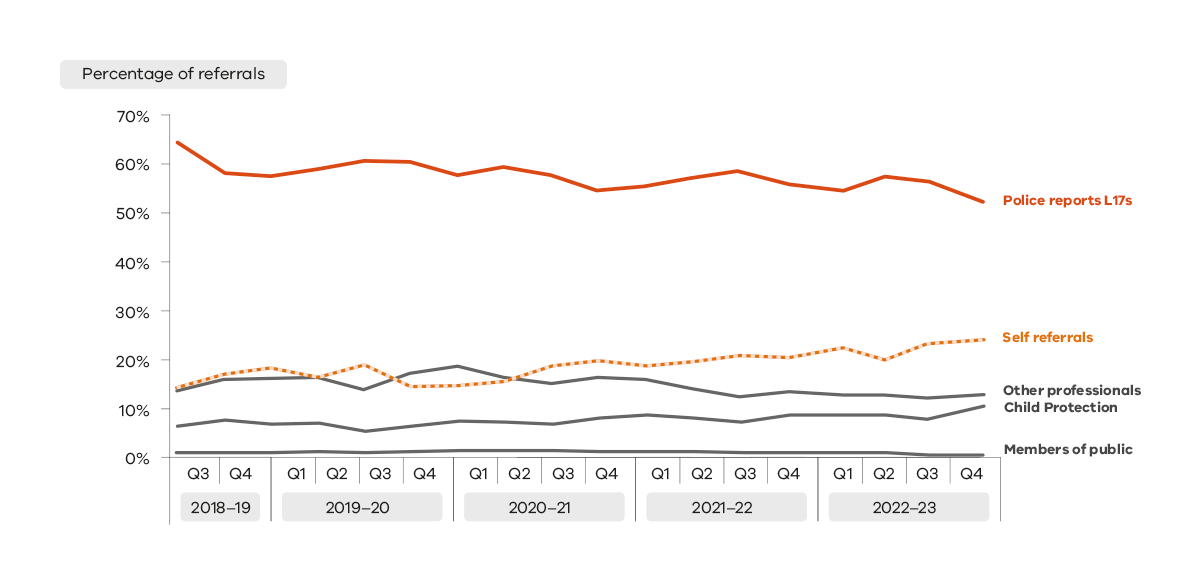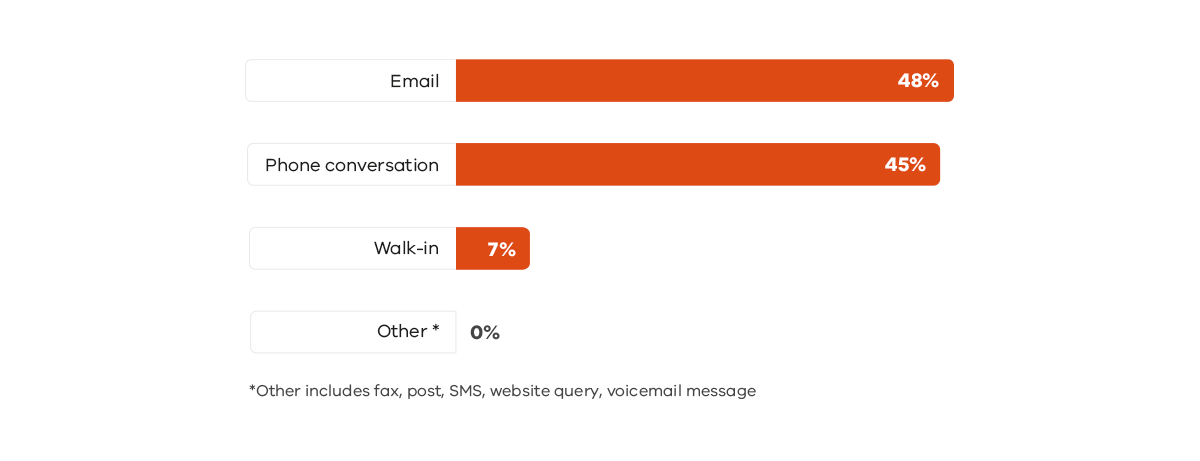How are people accessing The Orange Door network for assistance?
The Orange Door network aims to be accessible, safe, and welcoming to people, providing quick and simple access to support. Referrals to The Orange Door network have increased significantly since the state-wide rollout commenced in May 2018 having received over 425,000 referrals for individuals and families since then.
Referrals to The Orange Door network come from a range of sources including:
- L17 police referral reports
- direct contact (or ‘self-referral’)
- Child Protection
- other professional sources
- members of the public.
In 2022-23, The Orange Door network received almost 158,000 referrals alone. Almost half of the referrals received included at least one child. This represented a 48.8% increase in referrals since 2021-22, with the increase largely due to the continued expansion of The Orange Door network.
Since statewide rollout, the pattern in family violence referrals shows a consistent annual seasonal cycle. This is heavily influenced by L17 police referral reports (also known as L17s) where reporting peaks in summer and troughs in winter (Figure 4). The statewide pattern is also influenced by Child Protection referrals that routinely show a drop during school holidays – particularly over the summer period, noting that teachers are a major referral source to Child Protection and are unable to refer during school holidays.
In 2022-23 the most common way people accessed The Orange Door network was through L17 police referral reports which made up 55.4% of all referrals (Figure 5).[1] This represents a slight decrease from the previous year, and a more pronounced decrease from 2018-19 when L17 police referral reports were 63.9% of all referrals.
People do not need a formal referral to access The Orange Door network. Individuals and families who need support can make direct contact themselves, which is called a ‘self-referral’. These self-referrals include contact via phone, email or by physically attending The Orange Door.
Self-referrals have progressively increased since the commencement of The Orange Door network. In 2022-23, self-referrals comprised 22.4% of all referrals, up from 19.7% in 2021-22 and 17.2% in 2020-21. This may reflect the establishment of more visible and accessible entry points, as well as clients feeling more comfortable with reaching out to the Orange Door.
How does the community presence of The Orange Door network support safe and easy access?
The Orange Door network is designed to be a safe and accessible community service to make it easier for people seeking help for family violence or help with the wellbeing of children, young people and their families. People can contact The Orange Door in ways that are convenient, safe and accessible for them, including by telephone, email and in person. Each area has a toll-free telephone number and a direct email address to facilitate ease of contact.
People who make direct contact with The Orange Door through self-referral generally do so by telephone (81.2%), as do people making contact on behalf of someone they know (77.3%). Referrals received from professionals (excluding L17 police referral reports) are mostly received by email (88.4%) or telephone (11%). Across all types excluding L17 police referral reports, 47.6% of all referrals are received by email (Figure 6). L17 police referral reports are received via a dedicated system, and the large majority of Child Protection referrals are received via email.
Finding a local Orange Door
The Orange Door provides an entry point for family violence and family services that aims to ensure there is no wrong door to access high quality, consistent and effective support for children, young people and adults in communities.
The Orange Door network website[2] has a service finder function to support people to find the contact details for The Orange Door network in their area. Information contained on The Orange Door website is accessible in 50 different languages.
In 2022-23, the website was visited over 447,000 times by over 267,000 people. This represented a 27% increase in visits and a 22% increase in users compared to 2021-22. In 2022-23, the Caring for Children page had a 73% increase in page views.[3]
Notes
[1] Referrals that come directly from Victoria Police when there has been a report of an incident of family violence (known as ‘L17s’) are provided through a dedicated online portal (the L17 portal).
[2] The Orange Door network, Contact Us webpage, State Government of Victoria, accessed 7 November 2022.
[3] This data was sourced from the Single Digital Presence Dashboard, State Government of Victoria, accessed 21 November 2023.
Updated


